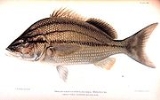
Haemulidae
Encyclopedia
The grunts are a family
, Haemulidae, of fishes in the order
Perciformes
. They are numerous and widespread, with about 150 species in 19 genera, found in tropical fresh, brackish and salt waters around the world. They are bottom-feeding predators, and named for their ability to produce sound by grinding their teeth.
Family (biology)
In biological classification, family is* a taxonomic rank. Other well-known ranks are life, domain, kingdom, phylum, class, order, genus, and species, with family fitting between order and genus. As for the other well-known ranks, there is the option of an immediately lower rank, indicated by the...
, Haemulidae, of fishes in the order
Order (biology)
In scientific classification used in biology, the order is# a taxonomic rank used in the classification of organisms. Other well-known ranks are life, domain, kingdom, phylum, class, family, genus, and species, with order fitting in between class and family...
Perciformes
Perciformes
The Perciformes, also called the Percomorphi or Acanthopteri, is one of the largest orders of vertebrates, containing about 40% of all bony fish. Perciformes means perch-like. They belong to the class of ray-finned fish and comprise over 7,000 species found in almost all aquatic environments...
. They are numerous and widespread, with about 150 species in 19 genera, found in tropical fresh, brackish and salt waters around the world. They are bottom-feeding predators, and named for their ability to produce sound by grinding their teeth.
Genera
- Anisotremus Gill, 1861
- Boridia Cuvier in Cuvier and Valenciennes, 1830
- Brachydeuterus Gill, 1862
- Conodon Cuvier in Cuvier and Valenciennes, 1830
- Diagramma Oken, 1817
- Genyatremus Gill, 1862
- Haemulon Cuvier, 1829
- Haemulopsis Steindachner, 1869
- HapalogenysHapalogenysHapalogenys or Barbeled grunters are the only genus of fish in the family Hapalogenyidae. The species of this genus are found in depths between 30 and 230 m in coastal areas and river mouths from the shores of Southern Japan to the Bay of Bengal and Northwestern Australia.Recent studies have shown...
Richardson, 1844 - Isacia Jordan and Fesler, 1893
- Microlepidotus Gill, 1862
- Orthopristis Girard, 1858
- Parakuhlia Pellegrin, 1913
- Parapristipoma Bleeker, 1873
- PlectorhinchusPlectorhinchusThe sweetlips, Plectorhinchus, are a genus in the family Haemulidae, with 35 species found in fresh, brackish and salt waters. These fish have big fleshy lips and tend to live on coral reefs in the Indo-Pacific in small groups or pairs...
Lacepède, 1801 - Pomadasys Lacepède, 1802
- Xenichthys Gill, 1863
- Xenistius Jordan and Gilbert, 1883
- Xenocys Jordan and Bollman, 1890
Species
Genus Anisotremus (Gill, 1861)
Genus Boridia (Cuvier in Cuvier and Valenciennes, 1830)
Genus Brachydeuterus (Gill, 1862)
Genus Conodon (Cuvier in Cuvier and Valenciennes, 1830)
Genus Diagramma (Oken, 1817)
Genus Genyatremus (Gill, 1862)
Genus Haemulon (Cuvier, 1829)
Genus Haemulopsis (Steindachner, 1869)
Genus Isacia (Jordan and Fesler, 1893)
Genus Microlepidotus (Gill, 1862)
Genus Orthopristis (Girard, 1858)
Genus Parakuhlia (Pellegrin, 1913)
Genus Parapristipoma (Bleeker, 1873)
| Genus Plectorhinchus (Lacepède, 1801)
Genus Pomadasys (Lacepède, 1802)
Genus Xenichthys (Gill, 1863)
Genus Xenistius (Jordan and Gilbert, 1883)
Genus Xenocys (Jordan and Bollman, 1890)
|

